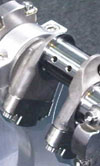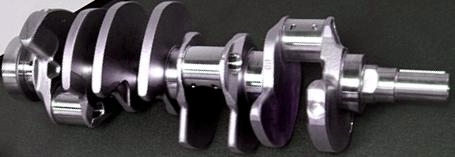Surface Hardening of Crankshafts
 In the previous article, we looked at the hardening and tempering of crankshafts. This month we shall look at the final and probably most important stage of heat-treatment, namely that of surface treatments, especially nitride hardening, more commonly known as ‘nitriding’. Nitriding is essentially a surface treatment, and its effect extends to a finite distance below the surface of the component.
In the previous article, we looked at the hardening and tempering of crankshafts. This month we shall look at the final and probably most important stage of heat-treatment, namely that of surface treatments, especially nitride hardening, more commonly known as ‘nitriding’. Nitriding is essentially a surface treatment, and its effect extends to a finite distance below the surface of the component.
Before we start, we should note that nitriding, whilst overwhelmingly popular for racing crankshafts is not universal. There are various other treatments providing local improvements to the fabric of the crankshaft close to the surface which have been used and remain popular today. ‘Tufftriding’ or variants of this nitro-carburising treatment still have some proponents, and it does provide a wear-resistant surface. However, ‘Tufftriding’ is only a very shallow treatment. Induction hardening (or more rarely flame hardening) is applied to bearing surfaces and fillets and aims to increase the bulk hardness of a layer near the surface, locally increasing strength and hence wear-resistance and fatigue properties. Carburising, or case hardening, is now largely out of favour, although it has been favoured in the past, before nitriding had been invented, or whilst nitriding was at a less advanced stage of development. This process diffuses carbon into the surface of a low-carbon steel, increasing its hardenability. This can impart large increases in hardness, with considerable case-depth and an attendant increase in wear-resistance and fatigue strength. However, owing to the harden, quench and temper nature of this treatment, distortion can be a very serious problem.
Hence we come to nitriding, which is favoured by most of the manufacturers of racing crankshafts, especially for single-piece machined items. Nitriding aims to diffuse nitrogen into the surface of specially alloyed steels, rich in elements which are strong nitride-formers, most especially Chromium, Molybdenum and occasionally Aluminium, Vanadium and Tungsten. There are two main types of nitride hardening processes, namely gas-nitriding and plasma nitriding. There are similarities in the two processes, although the methods are very different. Both take place at around 500°C (900°F) and both are relatively long processes, often taking tens of hours and, in some cases, well over 100 hours. The relatively low processing temperature compared to carburising means that distortion should be much less pronounced.

Gas nitriding is the older process of the two and still the most popular in terms of numbers of parts treated. The parts are suspended in a furnace with an atmosphere which is rich in nitrogen (most often dissociated ammonia). Gas nitriding produces a hard friable layer, often called the white layer. This can be very wear resistant, but owing to its brittle nature can become detached and cause problems as it forms very hard debris. Moreover, fatigue cracks can form in this layer, hence the reason why crankshafts are generally ground after gas-nitriding. Removal of the white layer in fillets is very important, and some manufacturers test parts using a simple chemical test to specifically check that this has been achieved.
Plasma nitriding is generally carried out under low pressure (a few millibars being common) with the parts being electrically charged and forming a cathode. The glow seem emanating from the parts has led to this process often being called glow-discharge nitriding. The heat produced by the discharge is what allows the nitrogen to diffuse into the material. There are some treatments which have relatively poor ‘coverage’ in small grooves or holes, which has caused some concern for manufacturers of crankshafts. However, there are newer treatments which can overcome this lack of penetration and can therefore treat oil holes etc.
Both methods are used at the highest levels of motorsport, although for more mainstream applications, gas nitriding remains more widespread.
Written by Wayne Ward.